385 Search Results for complex communication
October 19, 2017
by Carole Zangari -
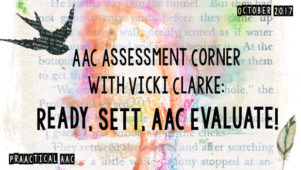
She’s bAACk! We couldn’t be happier to have another guest post on AAC assessment practices from Vicki Clarke of Dynamic Therapy Associates. In today’s post, she shares her tips and experiences for applying the SETT Framework to AAC assessment. If you are looking for information about how AACtual SLPs conduct their evaluations, Vicki’s posts are just what you need. You can view her previous contributions to the AAC Assessment Corner here. :::::::::::::::::::::::::::::::::::::::::::::::::::::::::::::::::::::::::::::::::::: Ready, SETT, AAC Evaluate! Last week I had the pleasure of joining the AAC After Work online conference hosted by Yapp Guru University. Jenna Coyer and I presented a session chatting about AAC assessment in emergent communicators. As we have worked to define our process for evaluation, we found ourselves repeatedly returning to the same approach our Assistive Technology teams use—the SETT Framework. The SETT Framework was developed by Joy Zabala as a process for making decisions about... [Read More...]
October 18, 2017
by Carole Zangari -

Today, we welcome back SLP Karen Natoci who is resuming her wonderful series on interactive book reading with AAC learners. Karen has supported AAC learners in different capacities throughout her career and is currently an AAC Supervisor with The Speech Pathology Group in Walnut Creek, California. You can read more about Karen at the end of her post and explore some of her previous posts here. PrAACtically Reading Book: The Family Book Written and Illustrated by Todd Parr (2003); Little, Brown and Company, Hachette Book Group AAC Competency Areas: Linguistic: Core Vocabulary Focus: big, small, same, different, like, help, my, I, Fringe Vocabulary focus: you, me, family, families, mom, dad, sister, brother (their names) Math Concept: concept of 1, more than 1, 1 versus 2, Actions: eat, noise/quiet, clean/messy Syntax: provide co-construction support, model same + one word more Strategic: Students will express a variety of communicative modalities to gain attention, and share... [Read More...]
October 2, 2017
by Carole Zangari -
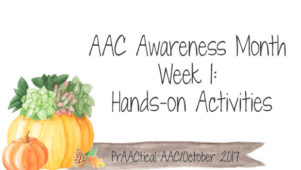
Welcome to ISAAC‘s 10th Annual International AAC Awareness Month! For the past decade, October has given us some extra opportunities to spread the word about all things AAC, and it’s pretty exciting to think back on all we’ve done and also to plan for the current year. Each week during AAC Awareness Month we’ll share suggestions for things to do to help others learn about a field that emerged to support children and adults with complex communication needs. This week, we’ll focus on hands-on activities. A popular approach to AAC Awareness Month is to invite a group of colleagues or families to come together and communicate only through AAC for the event. Some years, we’ve held ‘Silent Snack’ events before class where we put out a variety of board games and invited some of our AAC clients to come in and play along. They enjoyed serving as our AAC Ambassadors,... [Read More...]
September 4, 2017
by Carole Zangari -
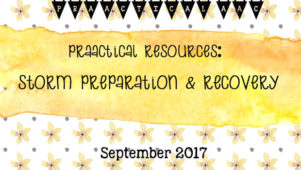
Before, during, and after – storms can be scary business and people with AAC needs are among the most vulnerable in extreme weather events. Our neighbors in Texas and the Gulf Coast are recovering from the devastating effects of Hurricane Harvey, and we’ve got our eye on Hurricane Irma’s path. Here are some resources that you can explore to help in storm preparation and recovery. Hurricane Harvey Please consider helping however you can. Get or Give Help AAC Relief for for Hurricane Harvey organized by USSAAC, Communication Circles, Disability Connections, and CERV of Monterey Matching donations by Prentke Romich Company Texas SLP Fund by Teachers Pay Teachers SLPs Therapy Materials for Flooded SLPs request TSTS Lite Version access (by email: Carrie@SpeechAndLanguageKids.com) Help for Harvey SLPs by Help for Harvey SLPs Facebook group Pass It On Reuse Center (for AT) Hurricane Resource page by Tobii Dynavox ... [Read More...]
August 31, 2017
by Carole Zangari -
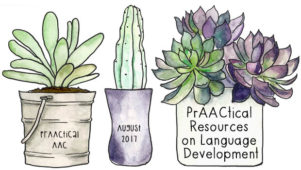
Are you planning language therapy or vocabulary instruction with AAC learners? For more than three decades, families, professionals, and people with complex communication needs have benefited from the insights and support of master clinician Gail Van Tatenhove. Among other things, Gail’s work has shaped the design of AAC technology and the practice of AAC in clinical and educational settings around the world. In today’s post, we share two of Gail’s resources on language development and academic vocabulary. Enjoy! Normal Language Acquisition & Children Using AAC Systems Academic Vocabulary
August 21, 2017
by Carole Zangari -

If you’ve been working in this field for awhile, chances are you’ve got some older voice output technology lying around. Poke around in the back of a closet or tucked way on top of the cupboards and you might encounter some hidden treasures. If you look w-a-a-a-y back there, you just might find a few digitized (recorded) speech devices that haven’t been used for some time. With only 2, 4, 8, 9, or 32 locations, these are generally insufficient for individuals with complex communication needs to use as their personal communication devices. When matched to the right purpose, though, these are wonderful tools that often have a lot of life left in them. How can we put those low tech AAC devices to work? Here are a few ideas to get us started. Build letter-sound knowledge: Program each cell with the sound of each letter so that the AAC student... [Read More...]
August 10, 2017
by Carole Zangari -
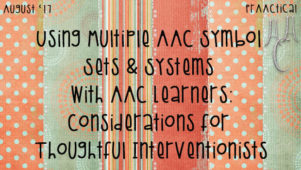
PCS, Pixons, Minspeak symbols, Smarty Symbols, Symbol Stix, CoughDrop Symbols, ARASAAC symbols, Mulberry symbols, Lesson Pix, Sclera symbols, and more. In terms of AAC symbol options, we are living in plentiful times. It isn’t uncommon to see situations like Jonah’s. On a typical school day, Jonah is likely to encounter at least three types of pictures for the same words. He has Smarty Symbols on his AAC app and a classroom core board with PCS, and is using instructional materials using Symbol Stix. These are each great ways of visually representing language, but here’s something to think about: Does it help or hurt Jonah to have 3 different pictures for the same word? There are many options in symbol sets and systems, and each has its own strengths and weaknesses. Here are some things to think about as you and your team are making these decisions. There is no empirical... [Read More...]
June 15, 2017
by Carole Zangari -
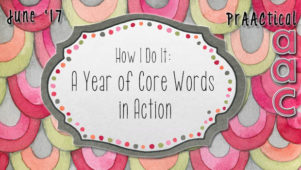
Some of the best resources are the ones that we can modify to use in ways that fit our own specific needs. In this post, SLP Kim Hurley, a graduate of Indiana University, shares her experiences in experimenting with the Year of Core Vocabulary approach. Kim has spent the past 15 years as a specialist for students with moderate and severe disabilities or complex communication needs in educational settings. Currently, she is employed by Forest Hills Special Education Cooperative, serving students in rural Monroe and Owen Counties in south central Indiana. Enjoy! :::::::::::::::::::::::::::::::::::::::::::::::::::::::::::::::::::::::::::::::: For the past 15 years, I have been working as an SLP serving public school students who have moderate to severe disabilities or complex communication needs. Several students benefit from various forms of augmentative communication, and in my years of work I have come to appreciate the flexibility that a robust, core word based system provides. However, when... [Read More...]
June 12, 2017
by Carole Zangari -
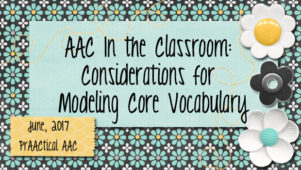
Here in the US, many schools just let out for summer vacation but some special education teachers and SLPs are already thinking about things they want to prepare over the school break so they’ll be ready for fall. Some are contemplating changes to the ways they support AAC in the classroom. We’ve heard from several who are planning to prioritize modeling of core vocabulary using aided language input. Before we start making large core boards and other support materials, though, it’s helpful to stop and think through some important issues. A little planning now will save time and effort in the long run. If you’re planning to do this kind of prep work over the summer, here are some questions for your team to consider. Does each student with complex communication needs have access to an AAC system that includes core vocabulary? If not, why not? In some cases, the students... [Read More...]
May 18, 2017
by Carole Zangari -
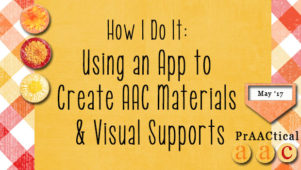
When we think of AAC apps, expressive communication and voice output generally come to mind. But there are other kinds of AAC apps, too, including those that are used to create printable materials. Today, we hear from a clinician who uses this kind of AAC app on a regular basis. Georgia Karavias is a speech language pathologist whose career has centered around working with school-aged children and adolescents who have physical disabilities and communication difficulties. Georgia is passionate about utilizing alternative access methods and inclusive technologies to enable independent communication using AAC systems. She currently works at Scope’s Communication and Inclusion Resource Centre (CIRC) as part of the communication access team in a community capacity building role. In this post, she talks about how she uses AAC and visual supports created with an app developed at her workplace. :::::::::::::::::::::::::::::::::::::::::::::::::::::::::::::::::::::::::::::::::::::::::::::::::::::::: I am a speech pathologist who has worked with children with complex... [Read More...]









